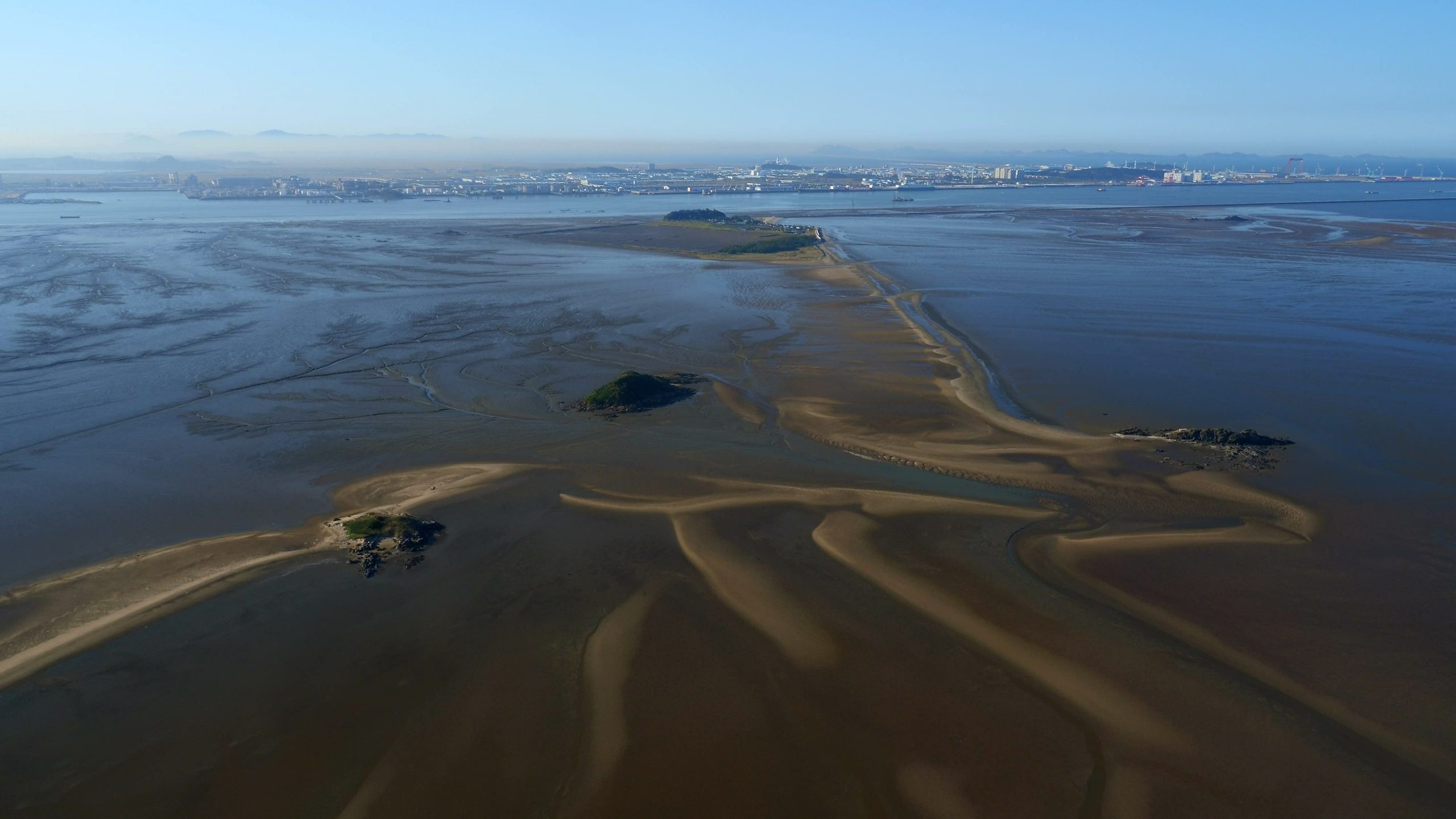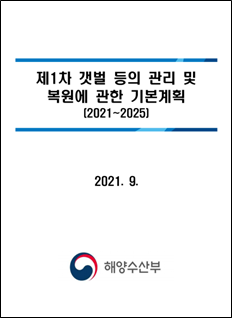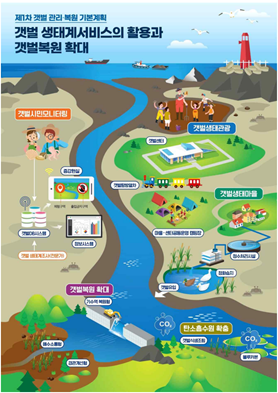 Yubudo © World Heritage Promotion Team of Korean Tidal Flat
Yubudo © World Heritage Promotion Team of Korean Tidal Flat
Following the Republic of Korea (ROK) getbol, or tidal flats World Heritage inscription, the wetland habitats’ “outstanding universal value” is recognized. Not only does it provide habitats for migratory waterbirds, but it plays a key role for ‘blue carbon’1, and aquacultural industry to the local community. Hence, regarding the value it holds, the Ministry of Ocean and Fisheries (MOF) of ROK has released ‘The Master Plan on Management and Ecological Restoration of Tidal flat and Adjacent Areas, first edition (2021-2025).’
 The master plan on Management and Ecological Restoration of Tidal Flat etc. (2021-2025) © MOF
The master plan on Management and Ecological Restoration of Tidal Flat etc. (2021-2025) © MOF
This Plan includes 3 major goals: 1) Strengthen scientific basis and integrative management on tidal flat threats; 2) Discover various values and enhance utility; 3) Systemize the entire cycle of tidal flat restoration. The 5 main strategies to achieve the goals in the plan are: 1& 2) Strengthen and expand tidal flat management, 3) Restore carbon sink through tidal flat recovery, 4) Increase tidal flat ecology service use, 5) Secure the governance of tidal flat management. The master plan was produced based on the ‘ (2021. Feb)’ which had been enacted to provide a policy and institutional basis for tidal flats sustainable use.
Mr. Moon, Seong-Hyeok, the minister of MOF said, “The first Master Plan, established in line with the international trend towards environmental conservation and carbon neutrality, will serve as a touchstone for wise use and sustainability of tidal flats for the next five years. We will work with the related ministries and local governments to carry out the Plan without any setbacks so that the results can be achieved.”
Meanwhile, MOF will aim to expand tidal flats nomination as Ramsar Sites, and further strengthen international cooperation with advanced countries in tidal flat management such as the three countries long the Wadden Sea. Furthermore, the cooperation system among RO Korea, China, Russia and DPRK are strengthened for migratory waterbirds and habitat conservation.
The five Strategies of the Master Plan
Strategy 1 & 2: Strengthen scientific base on management on tidal flats & expand the means of tidal flat management
Surveys will be held every 5 years which will analyze the use, environment, ecology, and pollution status of the tidal flats in ROK. The analysis will classify the tidal flat’s management level from excellent, good, fair, poor and very poor. ‘Excellent’ and ‘good’ will prioritize policies to maintain and promote its ecology and aquatic product productivity, while ‘poor’ and ‘very poor’ will prioritize to implement ecological and environmental improvement measures. Further measures will be made such as evaluation on tidal flats ecosystem services to capture benefits and values obtained through tidal flat use, an integrated management system to strengthen land-based pollutants management, followed with a management zone system. MOF also aims to implement customized management measures by experts to assist local governments and residents’ management capacity. The results of the survey analysis will help designate ‘clean tidal flats’ to ensure their aquatic products are branded and promoted for consumers to purchase. As well as MOF aims to designate safety management areas in tidal flats that have frequent accidents by introducing accident prevention guidance and facilities.
 The master plan (2021-2025) © MOF
The master plan (2021-2025) © MOF
Strategy 3: Secure carbon sink by restoring the tidal flat ecosystem
MOF aims to achieve expanding its initial tidal flat restoration project (1.5 Km2 of tidal flats have been restored since 2010) to a total 4.5 of tidal flat by 2025. Furthermore, it will include reverse reclamation of freshwater lakes and estuaries which used to be tidal flats. A step-by-step manual will be produced in promoting the restoration project efficiently and systematically, with continuous monitoring to verify the effectiveness of the restoration project. Tidal flats will be certified through research and pilot afforestation projects will be initiated from 2022.
Strategy 4: Enhance utilization of ecosystem service of tidal flats
The Plan aims strengthening ecosystem services of tidal flats such as promoting policies that will revitalize tidal flat ecotourism, operate a secretariat to train and educate ‘tidal flat ecology experts’ and form a training institution to design and evaluate its curriculum. ‘Tidal flat ecotourism certification system’ and ‘tidal flat eco-village designation system’ will be introduced followed by a plan to support programs that will expand the ecotourism infrastructure, discover and share good practices, and support experts, etc. In order to raise awareness of the value of tidal flats to the general public, youth, fisherman etc., virtual programs will be developed through Maritime Museum, and the Institute of Marine Biological Resources.
 Tidal flat ecosystem service and tidal flat restoration © MOF
Tidal flat ecosystem service and tidal flat restoration © MOF
Strategy 5: Tidal flat management governance
The MOF organizes and operates regional committees at the ecoregion level to systematically manage tidal flats. In addition, a system for integrated management of tidal flats at the ecoregion level is planned with a tidal flat supporting center for regional committees. MOF also plans to activate citizen science to increase the collection and use of survey data. Hence, MOF is preparing a legal basis to introduce citizen science system and build and operate a program and investigation platform for general citizens and environmental groups.
The survey and monitoring on waterbirds living along the ocean and coasts
In addition to the Master Plan, MOF recently announced a new plan to conduct more surveys for waterbirds living along the ocean and coasts by attaching satellite transmitters to locate their migration route along the EAA Flyway. Waterbirds living along the ocean and coasts are recognized as the highest taxon of food web, feeding off benthic organisms that inhabit tidal flats. Hence they are important indicators to estimate the biodiversity of tidal flats. MOF has therefore been conducting a national marine ecosystem survey to observe the status of waterbirds living along the ocean and coasts at 34 sites in ROK. This survey is focused to understand the migration routes and habitat usage of waterbirds living along the ocean and coasts, which will secure basic data for the home rage of waterbirds living along the ocean and coasts for the Phase 2 World Heritage nomination. This year a pilot survey will be conducted focusing endangered species such as ducks (E.g. Mallard, and Eastern Spot-billed Duck), terns and gulls (e.g. Vega Gull, Black-tailed Gull), and Black-faced Spoonbills. From 2022, the targeted species and regions will be expanded for major migratory and endangered species.
Prior to the 48th World heritage Committee, the MOF aims to include a new designation of national wetland protected area through close communication with major local governments and residents for Phase 2 of Getbol World Heritage nomination. Also, MOF will focus to implement the recommendations from the UNESCO World Heritage Committee.
Mr. Lee, Jae-young, head of the Marine Ecology Division of MOF said, “this survey will enable us to understand the characteristics and migration routes of waterbirds living along the ocean and coasts that come to Korea’s tidal flats through the EAAF.” He recognized the fundamental data will help establish various policies and international cooperation for protection for birds living along the ocean and coasts”
Reference Article Link (Korean only):
- The Master Plan on Management and Ecological Restoration of Tidal Flat and Adjacent Areas, first edition (2021-2025)
제1차 갯벌 등의 관리 및 복원에 관한 기본계획 [2021-2025] - Ministry of Oceans and Fisheries (MOF) press release
- News Article




